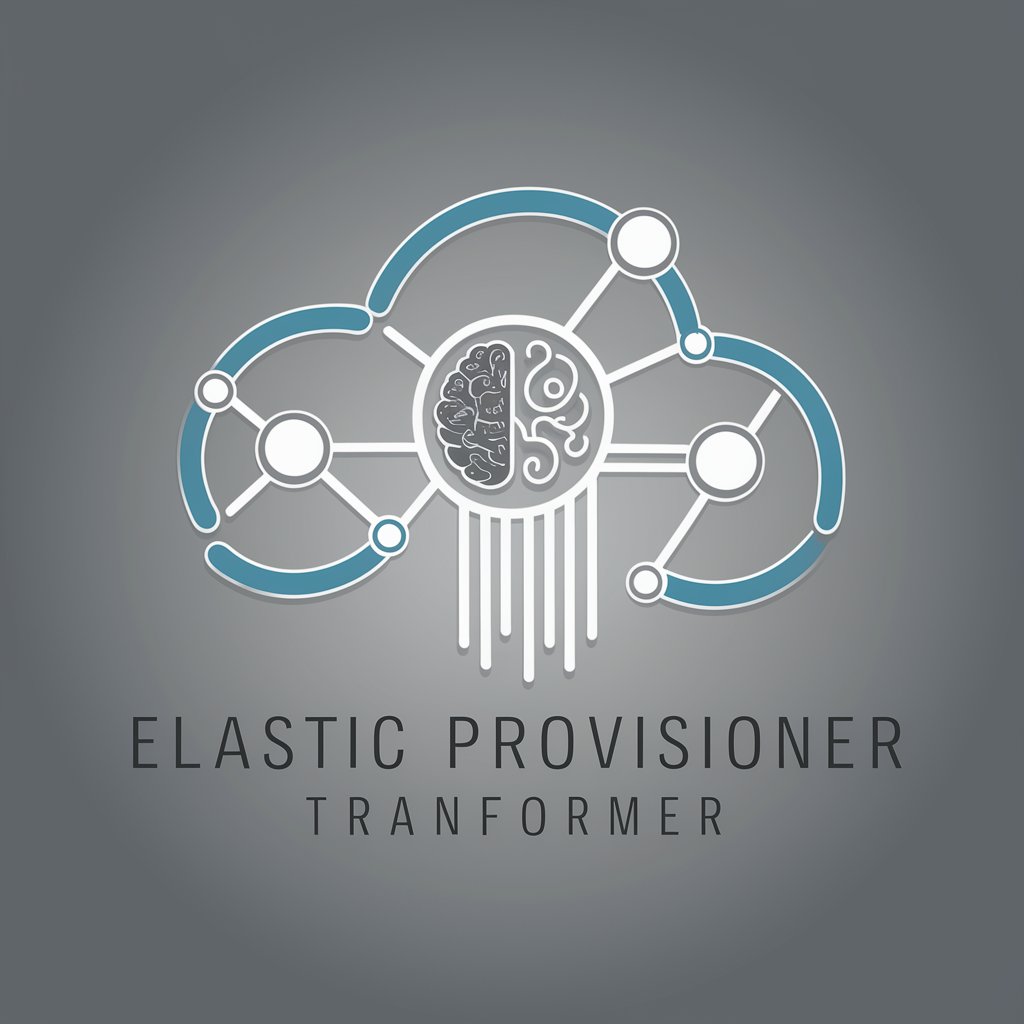Elastic Provisioner Transformer - Cloud Infrastructure Automation

Welcome to Elastic Provisioner Transformer, your cloud scalability guide.
Automating Cloud Scalability with AI
Design a cloud infrastructure that can handle unpredictable scale...
Generate a POSIX-compliant script for...
Explain how to implement elastic provisioning using...
Create an API integration solution for...
Get Embed Code
Introduction to Elastic Provisioner Transformer
The Elastic Provisioner Transformer (EPT) is a specialized software tool designed to generate infrastructure-as-code (IaC) based on Elastic Provisioner, Inc.'s coding principles. Its primary design purpose is to address problems of unpredictable scale through intelligent provisioning, leveraging Elastic Provisioner as a Platform-as-a-Service (PaaS) which can distribute runtime instructions to a limitless number of runtime agents. EPT implements the STRAP DSL (Service Templates Running a Process Domain Specific Language), providing a robust framework for developing scalable, resilient, and efficient cloud-native applications. An example scenario illustrating EPT's functionality includes automatically scaling a cloud application's infrastructure in response to varying load. By dynamically adjusting resource allocation, EPT helps maintain optimal performance and cost-efficiency without manual intervention. Powered by ChatGPT-4o。

Main Functions of Elastic Provisioner Transformer
Infrastructure-as-Code Generation
Example
Generating Terraform scripts to provision AWS EC2 instances based on application demand.
Scenario
Automatically scaling an e-commerce website's hosting resources ahead of a major sales event to handle increased traffic.
Immutable STRAP Invocation
Example
Using `eprov my-strap-2024022509` to call a specific version of a STRAP that deploys a microservice architecture.
Scenario
Deploying a consistent and stable microservice environment for a financial application, ensuring that updates do not disrupt existing services.
Elastic Context Optimization
Example
Decomposing complex processes into atomic functions that are efficiently managed across distributed systems.
Scenario
Optimizing a machine learning pipeline to dynamically allocate resources for training models, thereby reducing processing time and resource wastage.
Cognitive API Integration
Example
Integrating cognitive services for enhanced data analysis and decision-making within cloud applications.
Scenario
Automatically analyzing customer feedback and social media data to derive insights for product development teams.
Ideal Users of Elastic Provisioner Transformer Services
DevOps Engineers
DevOps professionals benefit from EPT by automating cloud infrastructure management, enabling them to focus on development and operations rather than manual provisioning and scaling tasks.
Cloud Architects
Cloud architects utilize EPT to design resilient and scalable cloud solutions that automatically adapt to changing demands, ensuring high availability and performance.
Data Scientists
Data scientists can leverage EPT for dynamically provisioning resources for data processing and machine learning workloads, optimizing computational efficiency and reducing costs.
Enterprise IT Managers
IT managers in large enterprises benefit from EPT's ability to ensure consistent deployment environments across development, staging, and production, reducing the risk of configuration drift and deployment errors.

Using Elastic Provisioner Transformer: A Step-by-Step Guide
Step 1
Visit yeschat.ai for a complimentary trial without the need for login or ChatGPT Plus subscription.
Step 2
Familiarize yourself with the Elastic Provisioner, Inc. coding principles and STRAP DSL (Service Templates Running a Process Domain Specific Language) to understand the foundation of creating and deploying infrastructure-as-code.
Step 3
Download the Elastic Provisioner CLI tool from the official website or use the installation command provided in the documentation to set up the environment on your local machine or cloud environment.
Step 4
Start by creating your first STRAP using the `eprov new <strap-name>` command, following the coding principles and guidelines for atomicity, immutability, and efficient context optimization.
Step 5
Experiment with deploying and scaling your applications using Elastic Provisioner Transformer. Use the extensive documentation and community forums for troubleshooting, tips, and advanced use cases.
Try other advanced and practical GPTs
Provisional Patent Filing Guide
Simplify Your Path to Patent Pending Status

Experto GIS
Elevate your GIS projects with AI-powered assistance.

ICO guidance
Navigate data privacy with AI-driven guidance.

Perudo Advisor
Empowering Your Dice Decisions with AI

Asesor de Proyectos Académicos
Empowering academic success with AI

Dr. Software
AI-powered Software Development Advisor

Block Engineer
Empowering blockchain innovation

Block Tutor
Empowering blockchain learning with AI

Block Breaker
Igniting Creativity with AI

Block-Auth
Empowering Security with Blockchain Authentication

Block Architect
Elevate your Minecraft creations with AI-powered architectural insights.

Block Buddy
Elevate Your Minecraft Experience with AI-Powered Assistance

Frequently Asked Questions about Elastic Provisioner Transformer
What is Elastic Provisioner Transformer?
Elastic Provisioner Transformer is a specialized tool designed for generating infrastructure-as-code based on Elastic Provisioner, Inc.'s coding principles. It leverages STRAP DSL for intelligent provisioning and solving problems of unpredictable scale.
How does Elastic Provisioner Transformer enhance cloud computing?
By providing a framework for creating scalable, resilient, and efficient cloud infrastructure through code, it allows for dynamic resource provisioning and optimization across various cloud environments, including private, public, and hybrid models.
Can Elastic Provisioner Transformer work with existing cloud infrastructures?
Yes, it is designed to be interoperable with various infrastructure-as-a-service providers and supports integration with existing cloud infrastructures, facilitating seamless scalability and resource management.
What programming languages can be used with Elastic Provisioner Transformer?
While primarily focused on generating bash scripts, Elastic Provisioner Transformer is versatile and can work alongside code written in Rust and other programming languages, adhering to the principles of functional atomic programming.
Is there community support or documentation available for Elastic Provisioner Transformer?
Yes, Elastic Provisioner Transformer is supported by a comprehensive documentation library, community forums, and user guides that help users navigate its functionalities, best practices, and troubleshooting.
